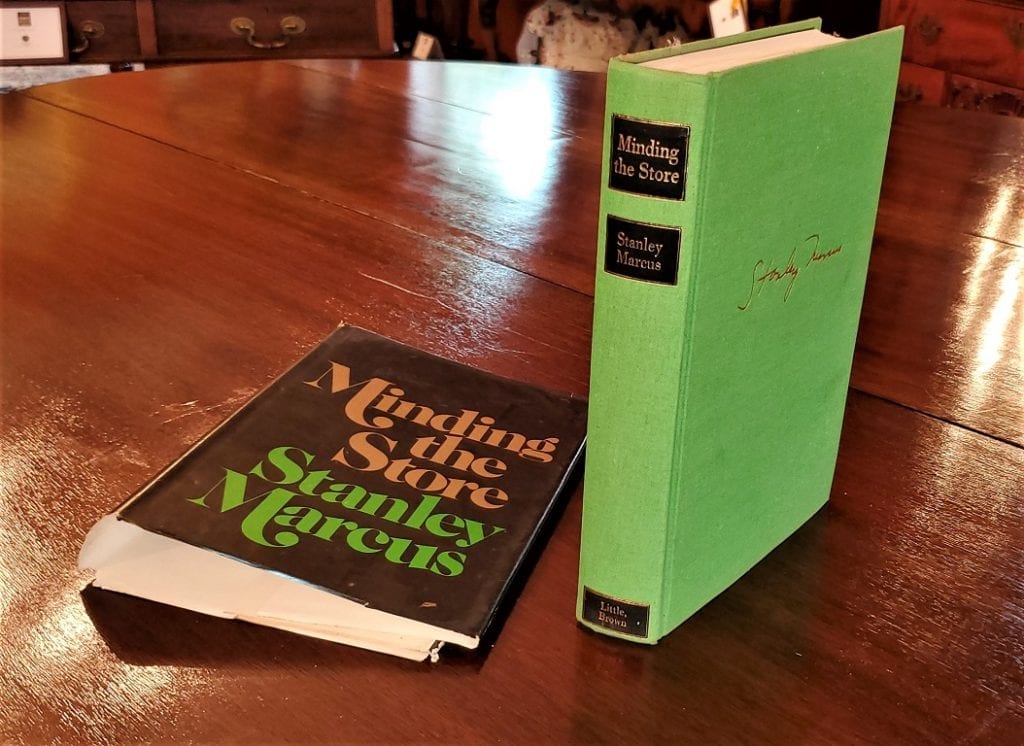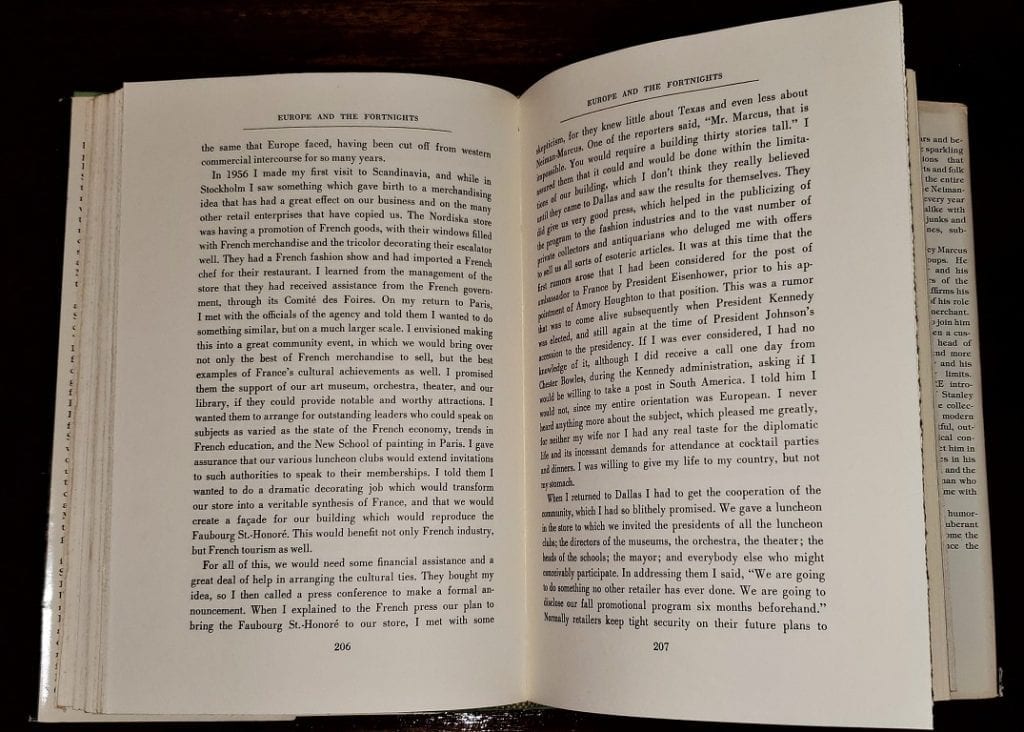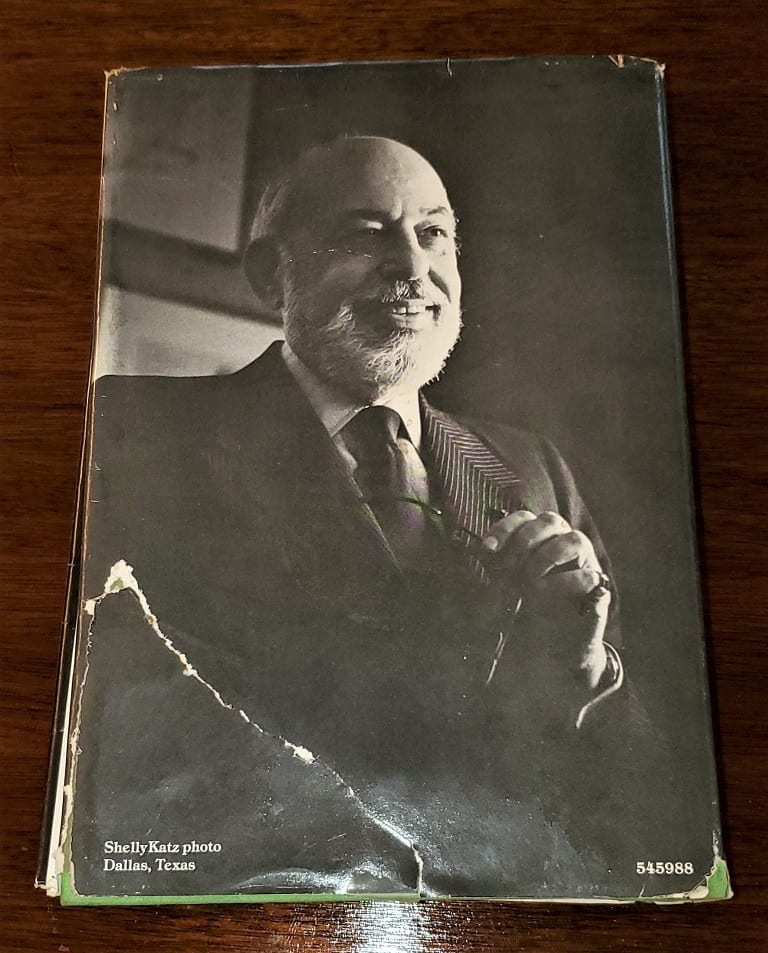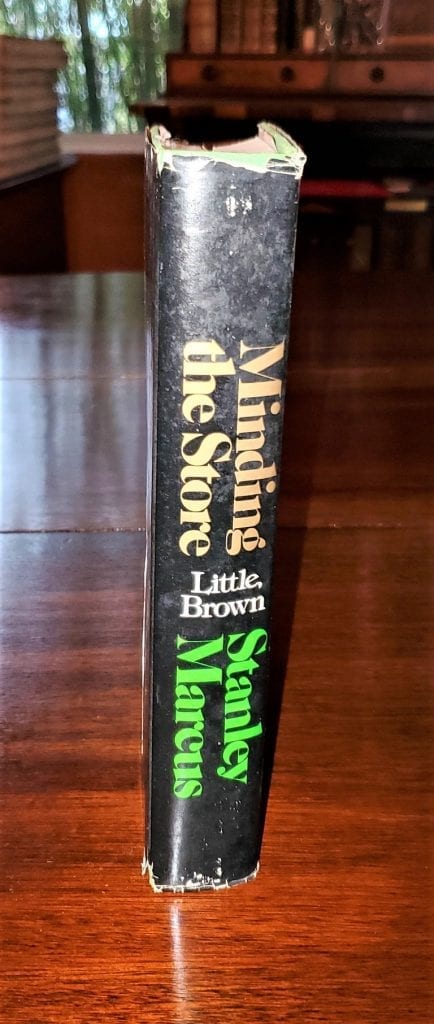Signed 1st Edition of ‘Minding the Store’ by Stanley Marcus
PRESENTING A SIGNED FIRST EDITION of ‘Minding the Store’ A Memoir by Stanley Marcus.
Published by Little, Brown (1974).
First Edition Second Printing. Pages 383.
Dust Cover in fair condition, some minor scuffing and repaired tear to back. Hardcover in excellent condition.
Original ‘Stanley Marcus’ signature in ink
Provenance: This book came from a Fine Private Estate in Highland Pk., Dallas, TX and the owners would have known Stanley Marcus personally.
ONE FOR OUR DALLAS CUSTOMERS OR AN ‘ESSENTIAL’ FOR LOVERS OF THIS QUALITY STORE
Neiman Marcus Group, Inc., originally Neiman-Marcus, is an American chain of luxurydepartment stores owned by the Neiman Marcus Group, headquartered in Dallas, Texas. The company also owns the Bergdorf Goodman department stores and operates a direct marketing division, Neiman Marcus Direct, which operates catalog and online operations under the Horchow, Neiman Marcus, and Bergdorf Goodman names. Neiman Marcus is currently owned by the Toronto-based Canada Pension Plan Investment Board and Los Angeles-based Ares Management.
Herbert Marcus, Sr., a former buyer with Dallas’ Sanger Brothers department store, had left his previous job to found a new business with his sister Carrie Marcus Neiman and her husband, A.L. Neiman, then employees of Sanger Brothers competitor A. Harris and Co. In 1907 the trio had $25,000 from the successful sales-promotion firm they had built in Atlanta, Georgia, and two potential investments into which to invest the funds. Rather than take a chance on an unknown “sugary soda pop business,” the three entrepreneurs rejected the fledgling Coca-Cola company and chose instead to return to Dallas to found a retail business. For this reason, early company CEO Peb Atera was quoted in 1957 as saying in jest that Neiman Marcus was “founded on bad business judgment.” The store, established on September 10, 1907, was lavishly furnished and stocked with clothing of a quality not commonly found in Texas. Within a few weeks, the store’s initial inventory, mostly acquired on a buying trip to New York made by Carrie, was completely sold out. Oil-rich Texans, welcoming the opportunity to flaunt their wealth in more sophisticated fashion than was previously possible, flocked to the new store. In spite of the Panic of 1907 set off only a few weeks after its opening, Neiman Marcus was instantly successful, and its first several years of operation were quite profitable.
In 1914 a fire destroyed the Neiman Marcus store and all of its merchandise. A temporary store was opened in 17 days. By the end of 1914, Neiman Marcus opened in its new, permanent location at the corner of Main Street and Ervay Street. With the opening of the flagship Neiman Marcus Building, the store increased its product selection to include accessories, lingerie, and children’s clothing, as well as expanding the women’s apparel department. In its first year at the new building, Neiman Marcus recorded a profit of $40,000 on sales of $700,000, nearly twice the totals reached in its last year at the original location.
In 1927 the store expanded and Neiman Marcus premiered the first weekly retail fashion show in the United States. The store staged a show called “One Hundred Years of Texas Fashions” in 1936 in honor of the centennial of Texas’ independence from Mexico. A later profile of the store, “Neiman Marcus of Texas”, described the “grandiose and elaborate” gala, noting, “It was on this occasion that one of the most critical among the store’s guests, Mrs. Edna Woolman Chase, editor of Vogue, expressing the sentiment of the store’s starry-eyed clientele, told the local press:
I dreamed all my life of the perfect store for women. Then I saw Neiman Marcus, and my dream came true.— Edna Woolman Chase, editor of Vogue (1936), quoted in Commentary 1957
In 1929 the store began offering menswear. During the 1930s and 1940s Neiman Marcus began to include less expensive clothing lines along with its high-end items, in response to the Great Depression and following war years. Between 1942 and 1944, sales at Neiman Marcus grew from $6 million to $11 million. Despite a major fire in 1946, the store continued to profit.
Herbert Marcus, Sr. died in 1950, and Carrie Neiman died two years later, leaving Stanley Marcus in charge of the company’s operations.
1950s–90s
The 1950s saw the addition of a $1.6 million store at 8300 Preston Road (in the Preston Center; the location currently occupied by the Tootsies store). It was 63,000-square-foot (5,900 m2), “inspired by the art and culture of Southwestern Indians” and “colors … copied from Indian weaving, pottery, and sand paintings”. The themed decor included Kachina figures on colored-glass murals and an Alexander Calder mobile named “Mariposa,” the Spanish word for butterfly. Art likewise was used as inspiration for Stanley Marcus’ seasonal campaigns to solicit new colors in fabrics, as he did the year that he borrowed 20 Paul Gauguin paintings — many of which had never been publicly exhibited — from collectors around the world and had the vivid colors translated into dyes for wool, silk, and leather. Area teachers cited the Gauguin exhibits as spurring a dramatic increase in art study.
In the 1950s and 1960s Gittings operated a portrait studio in Neiman Marcus. Clients included Hope Portocarrero, Lyndon Johnson, Howard Hughes, and the Shah of Iran, Mohammad Reza Pahlavi and his family. A late 1960s Christmas Book featured portraits of Wyatt Cooper, his wife Gloria Vanderbilt, and children Carter and Anderson Cooper.
The company continued its extravagant marketing efforts (including the launch of His and Her gifts in the famous Christmas Book) with the inauguration of Fortnight in 1957. The Fortnight was an annual presentation of fashions and culture from a particular country, held in late October and early November of each year, and was one of the most anticipated events in Dallas. It brought fashion, dignitaries, celebrities, exotic food and extravagant celebrations to the downtown store for 29 years.
Neiman Marcus opened its first store outside the Dallas/Fort Worth Metroplex in downtown Houston in 1957. The freestanding store was later replaced with a new anchor store located in the Houston Galleria in 1970. In 1965 the Preston Center store was closed and a new store, more than twice as big, was opened at NorthPark Center. Another branch in Fort Worth was also opened. By 1967 the four Neiman Marcus stores in operation were generating annual sales of $58.5 million, and the company’s profit for that year was in excess of $2 million. In 1968 the company merged with Broadway-Hale Stores, Inc., which enabled Neiman Marcus to expand at a much faster pace than would have been possible as an independent entity. In 1971, the first Neiman Marcus outside Texas opened in Bal Harbour, Florida. In subsequent years stores opened in over 30 cities across the United States, including Atlanta, Charlotte, Beverly Hills, Boston, Chicago, Las Vegas, Minneapolis, San Francisco and St. Louis. Neiman Marcus also had a letter of intent to open a 120,000 square foot store in downtown Cleveland in 1992 as part of an anchor for the upscale Tower City Center. However, the project did not come to fruition, instead opening its concept store in the 1990s. In 1988 the company’s name was officially changed from Neiman-Marcus to Neiman Marcus and the current logo was adopted.


Neiman Marcus in Boston‘s Copley Place
2000s–present
Stanley Marcus died on January 22, 2002. He had served as president and chairman of the board for the company. Marcus had been the architect behind the fashion shows, New York advertising for a strictly regional chain, in-store art exhibits, and the Christmas catalog with its outlandish His-and-Hers gifts, including vicuña coats, a pair of airplanes, “Noah’s Ark” (including pairs of animals), camels, and live tigers.
Over the last 20 years, ownership of Neiman Marcus has passed through several hands. In June 1987, the company was spun off from its retail parent, Carter Hawley Hale Stores, and became a publicly listed company. General Cinema, later to become Harcourt General, still had a roughly 60% controlling interest until 1999, when Neiman Marcus was fully spun off from its parent company. On May 2, 2005, Neiman Marcus Group was the subject of a leveraged buyout (LBO), selling itself to two private equity firms, Texas Pacific Group and Warburg Pincus.
The “Neiman-Marcus Collection,” comprising early account books, advertising and Christmas Catalog layouts, files on charity activities, past awards and presentations, and a collection of Stanley Marcus’s personal memorabilia, among many other items, is located in the Texas & Dallas History & Archives Division, 7th Floor, Main Library, Dallas Public Library, where it may be consulted by researchers.
In August 2013, Women’s Wear Daily reported that the Neiman Marcus Group was preparing for an initial public offering of its stock. In October 2013, the Neiman Marcus Group was sold for $6 billion to Ares Management and the Canada Pension Plan Investment Board. In August 2015, the company again announced it was preparing for an initial public offering. In late 2015 Neiman Marcus became a stand-alone company.
Neiman Marcus made headlines in November 2013 after the firm discovered a 25-carat rough diamond off Namibia’s coast, which was valued with a reserve price tag of $1.85 million. The diamond was referred to as the “Nam Diamond”.
In April 2019, Neiman Marcus acquired a minority stake in Fashionphile, an online resale platform for handbags, jewelry and accessories.
Link: https://en.wikipedia.org/wiki/Neiman_Marcus


Signed 1st Edition of ‘Minding the Store’ by Stanley Marcus
Provenance: See Above.
Condition: Very Good (see above)
Dimensions: 9.5 inches Tall, 7 inches Wide and 1.5 inches Deep
SALE PRICE NOW: $360

































